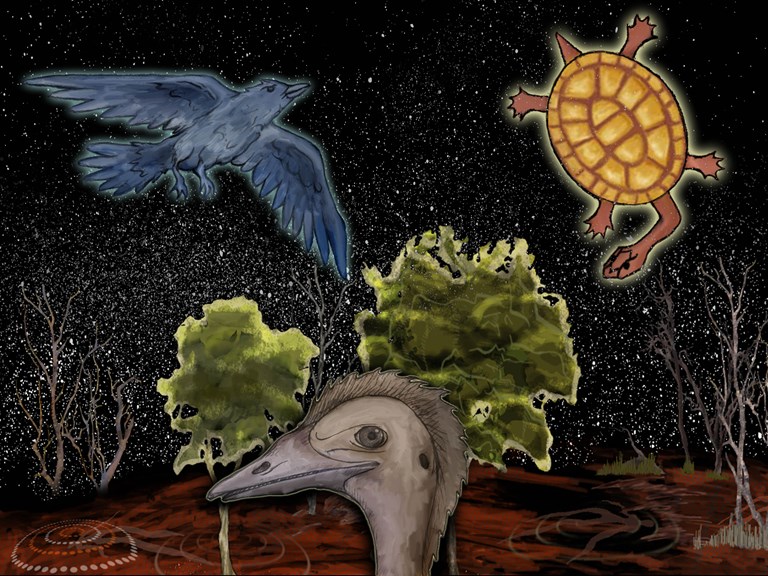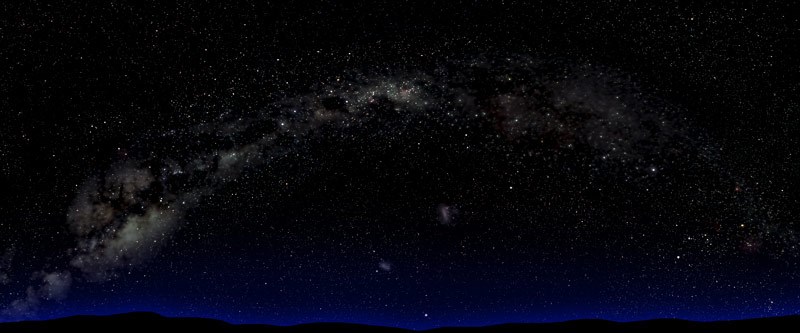Stories in the stars
This resource is designed to promote discussion and questioning about simple observable changes in the Australian night sky.
Its aim is to create an interest in the night sky so that students may begin to make simple observations either directly or by the use of digital resources.
Students may begin to investigate everyday phenomena and realise that these observations can be organised to reveal patterns.
Learning outcomes
In this activity children will:
- observe that the position of the stars changes in the night sky
- recall that we cannot see stars (except the Sun) during the day but can during the night
- recall that by careful observation patterns can be found in the stars
- state that stars can be described by names and through stories.
Engage
Suggested questions to engage students in analysing the image gallery at the bottom of this page:
- View the image below of the 'Southern Sky' and ask, 'What do you think this image is showing us?' Take note of students' use of key words such as, 'stars' and 'Milky Way' and 'Southern Cross'. Accept all good responses.
- Discuss that we can see stars during the night but not during the day (except for the Sun). Challenge the students' thinking by asking them why we cannot see the stars during the day.
- View the image below titled 'Boorong Constellations'. Do you recognise any of the characters which the Boorong people identify with?
- Are there any patterns (constellations) or pictures in the sky that you already know about?
Explore
- Do these stars as seen by the Boorong people, along with the ones you may already be familiar with, stay still in the sky or do they appear to move?
- Why do stars appear to move in the sky? (The stars do not remain fixed in the sky but appear to rotate, because the Earth is rotating on its axis. They rise in the east and set in the west.)
Explain
The collection of constellations described below the image titled 'Boorong Constellations' belong to the astronomical traditions of the Boorong people, who lived in north-west Victoria. The Boorong clan was a member of the Wergaia speaking peoples; their descendants live in north-west Victoria and throughout Victoria. Our knowledge of the Boorong astronomical traditions comes largely through the writing of William Stanbridge, a pastoralist who came to Victoria from England in 1841.
It is important to note that when we discuss constellations of stars, we are typically describing a group of stars forming a pattern in the night sky, such as the Southern Cross.
Elaborate
- Research who the Boorong people are and where they lived.
- Pick one of the Boorong characters shown in the image gallery below to create a poster about that Boorong constellation. Students can research or create their own stories about each character.
- Using available technology, search for images of constellations with the following names: Crux, Sagittarius, Scorpius and Orion. Draw and discuss these as a class.
- Research and discuss as a class where the Southern Cross can be found in the Australian sky.
- As a class explore video resources such as YouTube to view and discuss the movement of stars in the night sky.
- Research 'Do stars move in the night sky?'
- Research the names of major stars found in the sky over Australia.
Evaluate students' understanding
- Students create a poster about their favourite star pattern (constellation) that includes its name and shape.
Images
Southern Sky
Boorong constellations
Gellarlec: The song man is associated with the star Aldebran. Gellarlec stands in the northern sky. The name Gellarlec derives from the pink cockatoo, also known as the Major Mitchell Cockatoo. The colour is consistent with the star Aldebran that is a red colour.
Kulkunburra: A number of young men dancing, probably two because the word 'bulla' means two. 'Kulkun' is the word for young man or boy. This image is associated with the belt and scabbard of Orion.
Larnankurrk: A group of young women is beating time for Kulkunburra, the young dancing men. They are associated with the Pleiades star cluster. The women are beating time on their rolled-up possum skin cloaks.
Purra: Purra is the Red Kangaroo who is pursued and killed by two hunters called Yuree and Wanjel. Purra appears in the north-east sky just before dawn in mid to late August and disappears in the early evening in late February, followed later by her pursuers. A line drawn from Wanjel through Yuree towards the horizon connects with Purra. The major star in Purra is called Capella.
Yurree: Yurree and Wanjel are two young men who pursue Purra the red kangaroo and kill him and eat him at the commencement of 'the great heat', that is, midsummer.
Wanjel: Wanjel is the long-necked tortoise, based on the star called Pollux found in the northern sky. Pollux is described as an orange star and the long-necked tortoise has an under shell marked with orange-red patches when very young. This tortoise has a long snake-like neck and if roughly handled lets off a foul smelling liquid. It is sometimes known as the stinking tortoise.
Warepil: Warepil, the wedge-tailed eagle, is Australia's largest bird of prey. For the Boorong the eagle is centred on Sirius, the brightest star in the night sky. Warepil can be seen during summer and autumn.
Bunya: Bunya, pronounced 'boonyah' is the ringtail possum whose head coincides with the top star in the Southern Cross. The Cross is the tree that Bunyah runs up for safety as he is chased by a giant emu called Tchingal.


